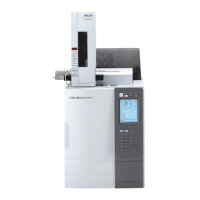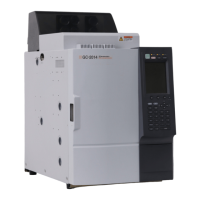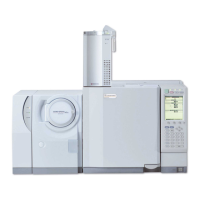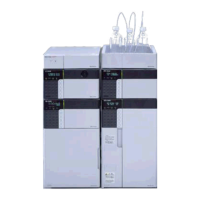3 AFC, APC
3.4 AFC and APC control
38
GC-2010 Plus
3.4.3 Split mode: “SPLITLESS” (AFC)
The control method changes only during the sampling time. During sampling time, the AFC
controls the TFC (Total Flow Controller) so that the output from the column inlet pressure
sensor becomes constant, and then controls the column inlet pressure.
After the sampling time, the AFC controls the total flow rate to keep it at a constant value
using the TFC (Total Flow Controller) inside the AFC. As in split mode, the ESC (Electronic
Split Controller) is controlled to maintain the column inlet pressure constant.
Figure 3.4.2 shows the control status during the sampling time with a split ratio of 1:40, a
velocity of 30 cm/sec, a purge flow rate of 3 ml/min, and a column oven temperature of 50 °C.
The column inlet pressure is calculated based on the linear velocity, the oven temperature,
the column inner diameter, the column length and the column film thickness, and is
automatically set to 49.6 kPa. In the same way, the column flow rate is automatically set to
1.67 ml/min.
When the sampling time expires, control is identical to the split mode, shown in Fig. 3.4.1
When the Control mode is set to “PRESS”, the column inlet pressure is controlled to remain
at 49.6 kPa regardress of the column oven temperature.
When the Control mode is set to “VELOCITY”, the column inlet pressure is set to a value
which keeps the linear velocity constant despite changes in the column oven temperature.
Even if the column oven temperature changes, as in programmed temperature analysis, the
linear velocity is always kept constant. Generally, when the column oven temperature
increases, the viscosity of the carrier gas also increases, and does not flow as easily.
Regardless of the Control mode, the ESC controls the column inlet pressure and the TFC
controls the total flow rate as shown in Fig. 3.4.1. (after the sampling time).
Fig. 3.4.2 Splitless control (during sampling time)
CARRIER IN
(GC rear)
PURGE VENT
SPLIT VENT
Column oven
(50 )
Flow rate
sensor
TFC
(Total Flow Controller)
Pressure sensor
Pressure sensor
SPC
(Septum Purge Controller)
ESC
(Electronic Split Controller):
Completely closed
Valve “b” Sensor “a”
Valve “b” is controlled so that the value of
sensor “a” remains constant.
Detector
99.1 kPa
4.67 ml/min
3 ml/min
0 ml/min
4.67 ml/min
C
P
C
P
S
3 ml/min
0 ml/min
1.67
ml/min
Column inner diameter : 0.32 mm
Column length : 25.0 m
Film thickness : 0.50 µm
Carrier gas : He
Injection
port

